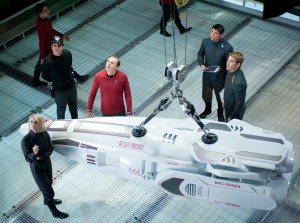Into Darkness falls short after high expectations
Possibly for the first time, it’s cool to be a Trekkie.
After an explosive re-emergence into popular culture, the Star Trek franchise is again revolutionizing science fiction and making it sexy.

Beam me up, Scotty · (Clockwise from front) Alice Eve is Carol, Simon Pegg is Scotty, Karl Urban is Bones and Chris Pine reprises his role of Kirk in the hotly anticipated Star Trek Into Darkness, the exciting, high-octane follow-up to 2009’s sensational blockbuster Star Trek. – Courtesy of Paramount Pictures
The crew of the U.S.S. Enterprise returns to explore the uncharted frontiers of space in Star Trek Into Darkness. These scientific quests, however, are quickly thwarted in lieu of a more political and militaristic agenda. When Starfleet headquarters in iconic San Francisco is attacked by a terrorist, Capt. James T. Kirk (Chris Pine) steers his crew into a mission for vengeance. The film is essentially a space-wide manhunt for the mysterious villain John Harrison, portrayed by the always electrifying Benedict Cumberbatch of Sherlock fame.
Considering the triumph of the first Star Trek film, it’s hard not to compare Star Trek Into Darkness to its predecessor. In 2009, Director J.J. Abrams took the franchise to places it had not boldly gone in years. With fresh faces and special effects that could hardly be fathomed in the 1960s, the sleek revamp completely transformed the series from a stale cult phenomenon to a fresh and universal blockbuster. Essentially, Abrams did for Star Trek what Christopher Nolan did for Batman.
Unfortunately, Star Trek Into Darkness tries to outdo itself and ultimately overexerts itself in an unnecessary attempt to prove that its initial success wasn’t a fluke. It can be inconsistent, excessively complex and overstuffed with frantic action sequences — a la Michael Bay’s Transformers — at its worst. Still, it’s salvaged by its visual spectacle and dynamic characters.
During the summer months, the box offices welcome a slew of epics, and it’s essential to have a critical eye for discerning which are worth forking over the cash. The latest Star Trek flick is undoubtedly worth the price of admission despite its shortcomings. Where it sacrifices coherence and fluency, it takes determined steps to flatter fans of the original series and sets up an inevitable third film and perhaps, if Abrams is feeling particularly adventurous, a new saga.
The first Star Trek commanded attention from its tour de force opening scene, in which we witness the chaotic birth of Kirk while his father makes a noble sacrifice to save his crew from a catastrophic enemy attack. The first scene of Star Trek Into Darkness, on the other hand, is visually striking but stops there. The screen is immediately cloaked in a vibrant magenta. Two cloaked figures sprint wildly through the red wood, in stark contrast to the entirely white-clad indigenous tribe pursuing them. Kirk has led his crew on a mission to freeze an erupting volcano that threatens to completely destroy the primitive planet and — of course — something has gone awry. In terms of pulse-quickening action, the scene falls flat and it immediately recalls comparison to the flawless execution of Abrams’ first attempt.
This unease of disappointment lingers throughout the duration of the film.
The major recurring fault is over-complication. The film incorporates an overbearing amount of backstory and motivation for each character and plot point, even for those who occupy only minutes of the entire story. Abrams wants to keep the film several steps ahead of the audience and, more often than not, he muddles a story that need not be smarter than its audience.
What made Abrams’ first Star Trek film so compelling was its simplicity, and its thrill of adventure. But in Into Darkness, plot twists become plot contortions, and it becomes easier to shake your head and brush off the layers of intricacy than to untangle who is doing what and why when the action resumes. That said, Abrams deserves recognition for reinstating one of the franchise’s most revered nemeses with the deliciously cold Cumberbatch. (Revisit the Star Trek flick released in 1982 to sate your curiosity.)
Star Trek Into Darkness maintains the rich diversity of characters that give the franchise so much of its appeal. Kirk is, again, charismatically arrogant and tenacious, contrasting perfectly with the calculated and relatively emotionless Spock (Zachary Quinto). The two are complemented by a talented cast that returns to play favorites McCoy (Karl Urban), Scotty (Simon Pegg) and Sulu (John Cho).
The characteristic witty banter between Spock and Kirk reignites for the sake of comedic relief, but the budding tension between the two begins to parlay into more mature themes. The foundation of friendship is tested when their opposing philosophies collide in the field.
Spock’s commitment to his companions is tested by Kirk, who questions his loyalty, and by his romantic interest Uhura (Zoe Saldana), a formerly strong female character weakened by her doubt in Spock’s ability to love. Kirk, on the other hand, finally learns lessons in humility, sacrifice and failure. Spock and Kirk share a moment of vulnerability in the end, one that softens their hard-headed resolves and allows them to acknowledge just how much they need each other.
The film tiptoes around issues of morality — Spock even offers the line “the needs of the many outweigh the needs of the few.” Abrams would do well to tap into the series’ philosophical reservoir rather than cater to action-hungry moviegoers, but perhaps it’s impossible to make science fiction cool and intellectual simultaneously. One can still hope.
In the last film, original Spock Leonard Nimoy passed the torch when he uttered the words “thrusters on full.” You heard the man, Abrams. Give the next one all she’s got.

An interesting side note on where part of the movie was filmed in at the Lawrence Livermore Lab in California.
https://www.llnl.gov/news/newsreleases/2013/May/NR-13-05-05.html